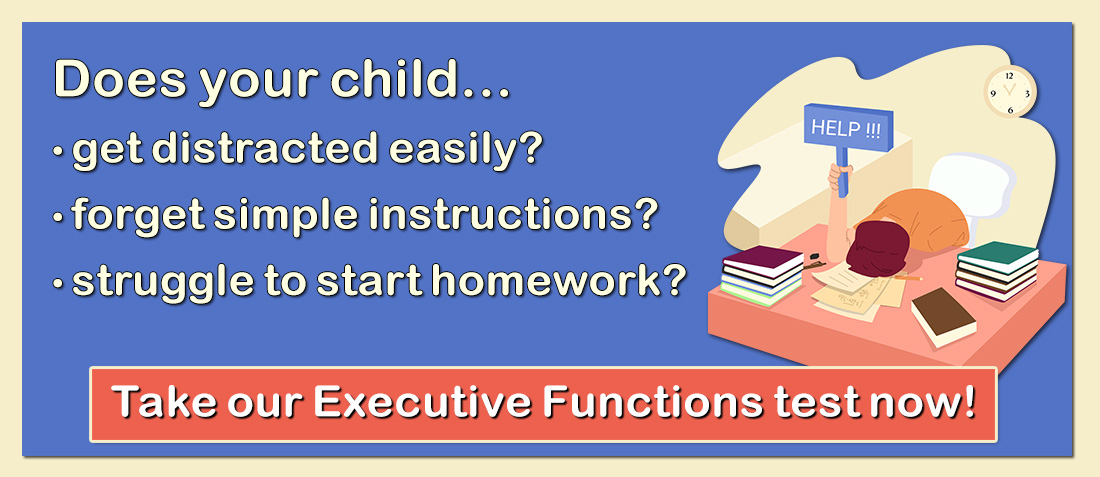Verbal working memory involves the ability to remember something and to perform an activity using this memory. This skill allows us to maintain information in mind so that we can use it for learning, reasoning, or producing a result. For example, this might involve shutting off a TV while remembering to gather your coat, keys, and bag before leaving the house on a trip. In school, verbal working memory is very important in taking notes, following multi-step directions, and doing mathematical calculations in your head. Working memory involves storing information temporarily and using that information in problem solving, motor activities, and self-control.
Verbal working memory plays an important role in reading comprehension and, for younger children, in the development of decoding skills to create reading fluency. It is a measure of the capacity of individuals to hold information in mind with the purpose of completing a task and helps them to remember the rules within a game or task. Individuals often use rehearsal strategies such as repeating things in order to buffet their memory strategy skills.
Children who can apply verbal working-memory skills effectively can remember and follow complicated directions, use previous experiences of learning in new situation, keep their engagement on tasks even while shifting activities within these tasks, reorganize their thoughts or materials in a fashion that is helpful for further learning, and control their attention to tasks. Children who struggle with verbal working memory remember only the first or last things in a series of directions that is given to them, have difficulty with jobs that have more than one step, forget what they are doing in the middle of things, have trouble remembering things such as directions and phone numbers for even a few minutes, describe themselves as being absent minded and often needing help from adults to remember directions, and are confused while attempting to complete multi-step mathematical problems.
Working Memory is one of the eleven “executive skills” identified by Dawson and Guare, and is a central executive skill in many theories. The capacity for working memory is seen as a necessary component in the ability to sustain attention, to make plans, and to be able to sustain one’s attention and effort towards purposeful, goal-directed behavior. Working memory is described by Welsh and Pennington (1988) as to encode memory and code relevant stimulus information into memory, by Robbins (1996) as “[a] likely [component] of executive functions,” or as a tool that holds in mind the information and goals that the central executive function has chosen according to Baddeley (1986).
Neuropsychological assessment of working memory includes working memory scales from the Wechsler Intelligence Scale for Children 4th Edition (WISC-IV), the Wechsler Adult Intelligence Scale 4th Edition (WAIS-IV), the Wide Range Assessment of Memory and Learning 2 (WRAML2), and the Automated Working Memory Assessment (AWMA).
The Executive Skills Questionnaire has a working memory scale that focuses primarily on one’s capacity to follow directions, and to use past experience to guide present behavior. The Brown ADD Scales has a scale that measures utilizing working memory and accessing recall. The Behavior Rating Inventory for Executive Functions has a working memory scale that assess attention span, concentration, and forgetfulness.
For More Information On Working Memory, Please Visit These Websites and Articles:
LearningWorks for Kids: What is Working Memory? This webpage defines working memory and explains how kids improve their working memory by playing videogames. It includes a video to explain in further detail.
National Institutes of Health: This online article researches and explains the differences between long-term, short-term and working memory in thorough, extensive detail.
Understood.org: This website discusses five different ways children use working memory, and explains why it’s an important skill to use. It also briefly explains ways that parents can help their children practice their working memory.
LearningWorks for Kids: Five Ways to Build Your Child’s Working Memory Skills. This webpage explains 5 different methods for helping your child practice and improve their working memory skills.
The Cognitive and Behavioral Characteristics of Children With Low Working Memory: This article includes a study that explores the cognitive and behavioral profiles of children with working memory impairments, and an overview of working memory deficits in children.
LearningWorks for Kids: 3 Ways to Improve Verbal Working Memory: This article provides strategies that can be used to improve a child’s verbal working memory skills.
Is Working Memory Training Effective? : This article published in the journal of Developmental Psychology discusses the potential of working memory training in youth.
Photo Credit: Brad Flickinger / CC BY 2.0
Receive online class information and helpful tips from Dr. Randy Kulman's LearningWorks for Kids |





